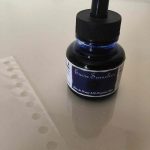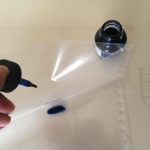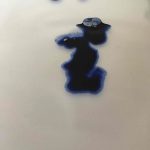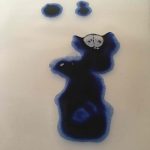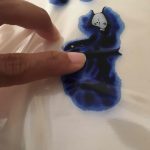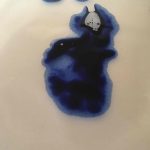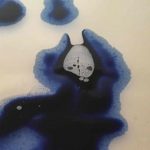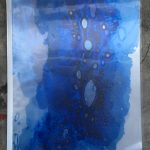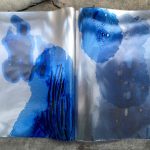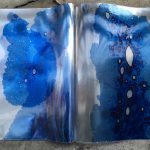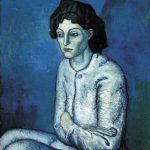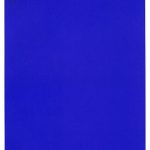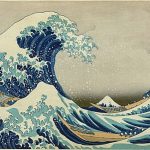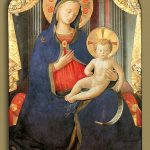Making the invisible visible
In my 3rd experiment I stepped out of the digital world and dived into the analogue world of painting. By chance I found a notebook with transparent covers. The transparency and the different levels in it encouraged me to experiment. Page after page I filled with Prussian blue ink.
Blue as the colour of distance: with its short waves it is refracted more than all other colours, so the sky in the distance appears blue, just like the sea. The Prussian blue reminds me of my home Berlin. Each page is an experiment and refers to all other pages. Narrating without words. About feelings, homesickness and sadness, but also about the sound of the sea and freedom, about shallows, the unconscious, dreams and other mysterious structures.
While searching for the right place to present my work, I accidentally came across a light table whose light brought out the transparent colour and its overlays on the pages even more precisely.
In the video, on the other hand, the view is made more difficult by the flickering, but the book begins to float.
In my experiment, the overcoming of inner distance to the outside world occupied me with the means of painting. The result was a wordless translation by making my inner experience with colour visible.
Blue is a symbolic and important colour in the history of art. Yves Klein painted monochrome in blue. Pablo Picasso’s blue period is famous. The first in the series 36 Views of Mount Fuji is Hokusai’s most famous print.
- https://en.wikipedia.org/wiki/Picasso%27s_Blue_Period#/media/File:Pablo_Picasso,_1901-02,_Femme_aux_Bras_Croisés,_Woman_with_Folded_Arms_(Madchenbildnis),_oil_on_canvas,_81_×_58_cm_(32_×_23_in).jpg
- https://de.wikipedia.org/wiki/Yves_Klein#/media/Datei:Untitled_blue_monochrome2.png
- https://en.wikipedia.org/wiki/Hokusai#/media/File:Great_Wave_off_Kanagawa2.jpg
In the Middle Ages blue stood for the divine.
- https://en.wikipedia.org/wiki/Blue#/media/File:Angelico,_madonna_col_bambino,_pinacoteca_sabauda.jpg
Prussian blue was used for blueprints in architecture.
- https://en.wikipedia.org/wiki/Blueprint#/media/File:LaBelle_Blueprint.jpg
The color blue is entwined with myths, stories and legends. The blue flower as a symbol of longing. Blue uniforms, flags, porcelain and hyperlinks. In Germany you are drunk if you are blue. In the English language you are sad when you feel blue. The blues expresses this musically.
In US and European public opinion polls it is the most popular colour, chosen by almost half of both men and women as their favourite colour. (Heller 2009, p. 22.) Surveys in the US and Europe show that blue is the colour most commonly associated with harmony, faithfulness, confidence, distance, infinity, the imagination, cold, and sometimes with sadness. (Heller 2009, p. 24.)
- https://de.wikipedia.org/wiki/Erde
And not to mention: …from a distance we live on the blue planet.
The complexity of the colour blue, its illusions, dreams and depths tell stories and make visible what we cannot see with our eyes alone.
